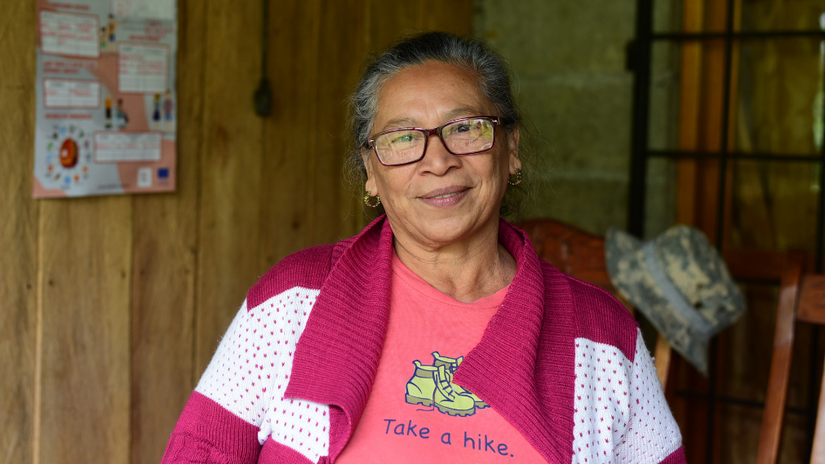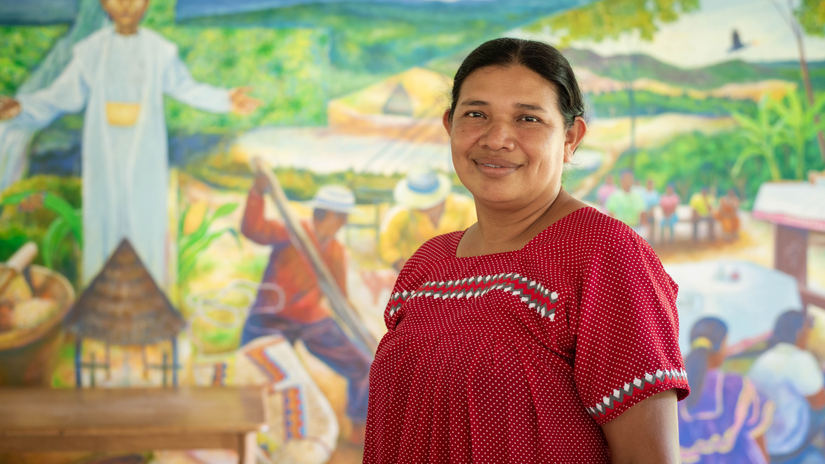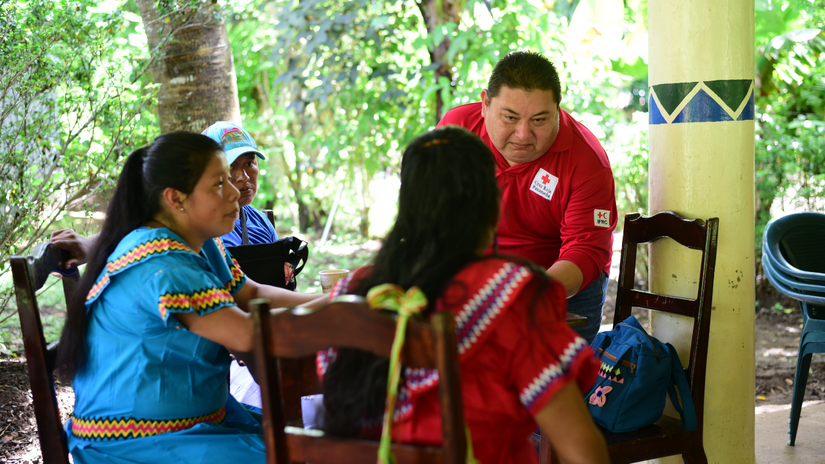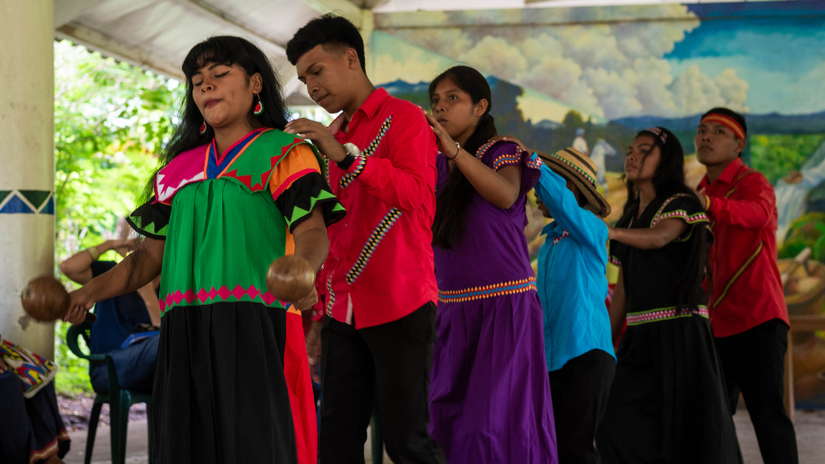In the last fifty years, Panama has experienced an increase in extreme weather events, such as intense and prolonged rains, windstorms, floods, droughts, forest fires, landslides, tropical cyclones and the effects of El Niño and La Niña phenomena.
Right now, Panama is facing a major drought. But in recent years there have also been severe storms — such as hurricanes Eta and Iota. Those storms flooded most of Soloy, an area that is part of the Ngäbe indigenous territory, and the Tierras Altas district in Chiriquí.
This part of northwestern Panama is also one of the main agricultural areas in the country, and one of the most affected by these hurricanes, which have prompted the community to prepare for possible similar events.
Since then, disaster risk management has become a fundamental task, driven by the active participation of indigenous community leaders such as Dalia, Eusebio and Wilfredo from Soloy, and the commitment of neighbours such as Doña María, who lives in Las Nubes, in Tierras Altas. These efforts enjoy the full support of local actors and in particular, the Panamanian Red Cross.
At the COP Global Summit on climate change going on this week, the IFRC continues to emphasize that communities must be at the center of disaster and climate crisis preparedness. Here are the three main reasons why:
1. It’s going to happen again: Preparing for recurrent disasters

A resident of Las Nubes, Tierras Altas community, Doña Maria prepared a family evacuation plan to protect her home and loved ones from future floods.
Photo: IFRC/Panamanian Red Cross
"One of the situations that occur during the winter season are the flooding of rivers, because we have a large number of rivers in the community; and also landslides, which leave houses and roads affected", says Eusebio Bejarano, a leader in the community of Soloy.
That is why the Panamanian Red Cross worked alongside the community as it prepared an assessment and established Community Response Brigades. In addition, they have begun using something called the Nexus Environmental Assessment Tool, which helps to quickly identify environmental concerns before designing longer-term emergency or recovery interventions.
"It is an environmental assessment tool that has allowed us to understand the context of the activities carried out by the community and, above all, how we can work to protect the livelihoods of this community, which is rural and depends heavily on subsistence agriculture", explains Daniel González, head of risk management for the Panamanian Red Cross.
At the family and individual level, actions can also be taken to protect the homes of people like Doña María, who lives near the river bank and has worked on a family evacuation plan. She is now prepared to act in case of flooding.
2. It’s local people who are first to respond: Strengthening community response capacities

Dalia lives in Soloy and is the leader of a local disaster response brigade that focuses on psychosocial support.
Photo: IFRC/Panamanian Red Cross
Part of the preparedness process requires communities to strengthen their learning, technical and leadership capacities to better adapt to the crisis situations. This is critical because community organizations are the first to respond when disasters occur and often have access to areas where international actors do not.
The presence of these community groups before, during and after crises means they can more readily respond while also fostering long-term preparedness and recovery.
"We must prepare ourselves in First Aid, the authorities must be trained, the teaching staff and the community,” says Dalia, the leader of the Psychosocial Support Brigade in Soloy. “The Red Cross has brought different types of training, in which young people have participated, but we need more communities and more young people to get involved."
The implementation of educational projects, such as blue schools, which incorporate learning about water, sanitation and hygiene (WASH), recycling and school gardens, are a sample of the actions that the communities are carrying out with the support of the Panamanian Red Cross.
"We have trained the Fire Fighting Brigade, the First Aid Brigade; but we have also worked on strengthening resilience in three schools in Alto Bonito, Boca de Remedio and Soloy,” says Daniel González, head of risk management of the Panamanian Red Cross. “In addition, we have provided them with first aid kits and rigid boards, along with training for teachers and the educational community."

Daniel González, head of risk management of the Panamanian Red Cross, has been working alongside the indigenous community of Soloy, who are preparing themselves for increasing shocks related to the climate crisis.
Photo: IFRC/Panamanian Red Cross
3. Communities know what’s at stake: Strengthening community resilience
Communities are the heart of climate-crisis preparedness because they know what’s at stake — their environment and the survival of their way of life. In the face of the climate crisis and increasingly uncertain scenarios, this is why the Red Cross works with communities to strengthen local resilience to climate-related shocks.
"We have worked hand-in-hand with the Red Cross, organizing and preparing for situations that have been occurring with the climate crisis, focusing a lot on the community, working with leadership, working with authorities and visiting communities", says Eusebio Bejarano.
Community resilience enables communities to prepare for disasters and create a safe, healthy and prosperous future. To do this, communities must record information on all relevant hazards and their causes, health threats, hazards, conflict, violence, climate crisis, environmental degradation. Only then will they be able to set priorities together and decide how best to address them.
Another leader from Soloy, Wilfredo highlights the importance of promoting empathy and collective care and stresses the importance of caring for nature. He emphasizes that the mountains and rivers are fundamental for community life. The Ngäbe indigenous population has also brought to the table the need to take cultural elements such as language into account when planning preparedness actions.
A resilient community is one that is experienced, healthy and able to meet its basic needs. It’s a community that has economic opportunities, well-maintained and accessible infrastructure and services, and can manage its natural assets in harmony with the environment. And it’s a community that can focus on moving forward, and on things that bring joy and meaning, rather than continually recovering from the sudden shocks of the climate crisis.
Disaster preparedness and community resilience actions are also being carried out in Guatemala, Honduras, El Salvador and Ecuador, thanks to the Programmatic Partnership between the IFRC network and the European Union, which provides strategic, flexible, long-term and predictable funding, so that National Societies can act before an emergency occurs.

